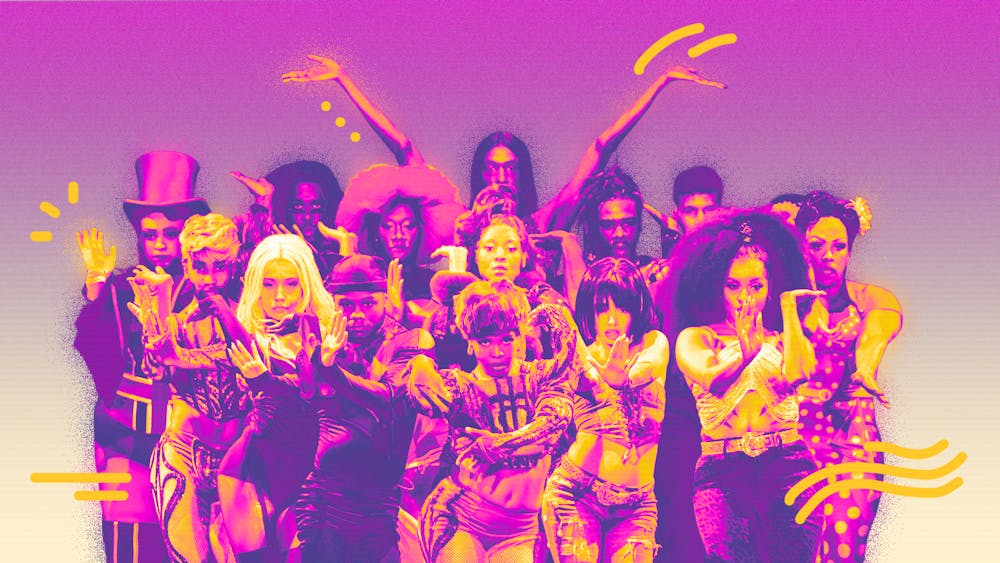You know that scene in Elvis where the teenage girls in his audience start freaking out, shaking, screaming, sobbing, overcome by an intense, invisible hysteria? I always assumed that was exaggerated until I saw Cats. Not the OG Andrew Lloyd Webber musical or the horrendously CGI’d movie, but Cats: “The Jellicle Ball”—a queer reimagining that shines a light on contemporary Ballroom culture.
When I, still shaking from excitement, first told my friends about this radical remake, I got mixed reactions: “It just isn’t making sense in my head,” says a friend who was trying to process my chaotic fangirling. “I don’t want to see Cats,” texts my sister, who feared I would drag her to another show, and a supportive, if not grammatically correct, “OMG IM SO JEALOUS I LOVE CATTS.”
The original source material is T.S. Eliot’s Old Possum’s Book of Practical Cats, a collection of light poetry investigating the lives of lovable, furry deviants. Now, Eliot loved cats—it’s unknown just how many cats he owned in his lifetime, but he gave them fun, perfect names like Jellylorum, George Pushdragon, and Pettipaws. He’d fit right in with Instagram cat owner influencers.
Elliot’s collection eventually inspired composer Andrew Lloyd Webber to create a musical, with the majority of the musical numbers in Cats coming straight from Practical Cats. “Memory,” the climax of the musical and perhaps its best–known song, was based on one of Eliot’s unpublished poems. As such, Eliot’s charm and creative vision is perfectly preserved within Cats—telling a connected tale of magical and respectable cats.
The highly successful musical ran on Broadway for 18 years, reshaping the technology, aesthetic, and marketing of musical theater everywhere, and inspired many adaptations of its own, to various degrees of success.
The infamous 2019 Cats film loses the plot entirely, not just from its unsettling visual effects, but because it doesn’t understand the original musical or poetry. It introduces plot points that go nowhere, creates dissonance between the jaunty soundtrack and unnecessary scenes, and tries so hard to justify itself that it all falls apart.
Directly opposite, you can find Cats: “The Jellicle Ball.” The Jellicle Ball has not only received Andrew Lloyd Webber’s approval—with the production’s music supervisor William Waldrop describing his reaction as “very positive”—but based on Eliot’s own words, is “good” art. In Eliot’s essay “Tradition and the Individual Talent,” he states that in good art, “impressions and experiences combine in peculiar and unexpected ways.” He argues that art should be distinct from the personality of the writer, and that new art should respect “tradition,” a term he defines as a perception of the presence and “pastness” of the past.
The Jellicle Ball certainly combines different themes and experiences in an unexpected way, but also does so uniquely and respectfully. Created by Zhailon Levingston and Bill Rauch, The Jellicle Ball is like an amalgamation of Cats and Paris Is Burning. It serves as a tribute to the living and dead legends of New York ball culture, and introduces a cast of dancers, musical theater legends, and Ballroom elders.
This Ballroom doesn’t refer to the waltzes of Europe, but rather the queer and trans–focused scene created by Black and Latinx people. Recently brought into the mainstream by the show Pose, the Ballroom scene first began in the Jazz Age, when rampant racism in white–run drag balls led Black and Latinx drag queens to create space for themselves, forming underground queer communities of color which eventually shaped into the modern Ballroom scene we know today.
The Jellicle Ball takes the music and songs from Cats and recontextualizes them. Instead of an annual gathering of junkyard cats choosing who deserves to go to heaven, the Jellicle Ball is a competition, with a grand prize that cements one as an Icon. The loosely connected songs become runway categories like “body,” “labels,” or “hair affair,” complete with death drops and voguing. The complicated family trees form into Houses, chosen families and support systems for queer people who become disconnected from their birth parents. Suddenly, the names that cats choose for themselves are not just a chuckle at the dramatic behavior of our favorite pets, but a celebration, a spotlight on a community of people that respected and embraced their identity while being shunned by a homophobic, transphobic, and racist world.
The production easily falls into place, with some minor—and tasteful—changes. With a stacked cast of musical theater and Ballroom icons like André De Shields as Old Deuteronomy, Junior LaBeija as Gus, and Chasity Moore as Grizabella, The Jellicle Ball appreciates the history and culture driving the revival without appropriating.
In its three times–extended yet far–too–limited run from June 13 through September 8 at PAC NYC, The Jellicle Ball proves that by reincarnating Cats with its voguing makeover, risk has its rewards. It’s a sign for the future of theater—shining proof of a space being built that doesn’t shy away from the histories and legacies of queer performers of color.

